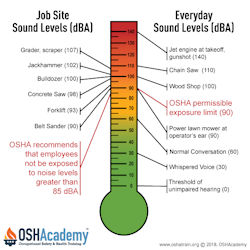Noise
What is Noise?
Noise is unwanted or harmful sound that can interfere with normal activities such as communication, concentration, or relaxation. In the workplace, noise often comes from machines, tools, equipment, or work processes. If noise levels are too high or continue for long periods, they can damage hearing and create other health and safety problems. Industrial hygienists measure and control noise to protect workers from these risks.
What is Sound?
Sound is a type of energy made by vibrations that travel through air, water, or solid materials. These vibrations create waves that the ears can hear. Noise, on the other hand, is usually unwanted or unpleasant sound. While all noise is sound, not all sound is noise.
Sound is measured in decibels (dBA), a unit used to measure sound levels while taking into account how the human ear hears different frequencies. The "A" in dBA stands for A-weighting, which adjusts the measurement to reflect that people hear frequencies better than others. For example, the ear is less sensitive to very low or very high sounds, so dBA reduces the effect of those sounds in the measurement.
As the infographic illustrates, a soft whisper is around 30 dBA, while a bulldozer can be 100 dBA. Sound can also be measured by frequency, which is how fast the sound waves vibrate. Frequency is measured in hertz (Hz) and tells if a sound is high or low in pitch.
Workers are most sensitive to sounds in the frequency range of about 2,000 to 5,000 hertz (Hz). This range includes many of the sounds used in speech, which is important for communication in the workplace. The human ear is especially good at detecting sounds in this range, so these frequencies can seem louder and more noticeable compared to very low or very high sounds.
Hazards
Exposure to loud noise in the workplace creates serious health risks that go beyond just hearing problems. Noise affects both short-term and long-term health, contributes to stress and fatigue, and increases the risk of accidents. It can also reduce overall quality of life by making communication and social interaction more difficult.
The most important health hazards of noise include:
- Hearing loss: Long-term exposure to high noise levels can permanently damage the tiny hair cells in the inner ear. Once these cells are destroyed, they do not grow back, which means the hearing loss is permanent. Unlike other medical conditions, this type of damage cannot be corrected by surgery or hearing aids, making prevention the only effective solution.
- Short-term effects: Exposure to loud noise, even for a short period, may cause temporary changes in hearing. Workers may experience a “stuffed” feeling in their ears or ringing, known as tinnitus. While these symptoms may fade after several minutes or hours, repeated short-term exposures can accumulate over time and lead to permanent tinnitus or hearing loss.
- Physical and psychological effects: Constant exposure to loud noise places stress on the body, leading to fatigue, increased blood pressure, and reduced concentration. It can also cause irritability, anxiety, and other psychological strain that interferes with job performance and overall well-being.
- Workplace safety risks: Excessive noise makes it difficult for workers to hear warning signals, alarms, or verbal instructions. This can increase the risk of accidents, especially in environments with moving machinery or vehicles. Poor communication caused by noise can also lead to mistakes and injuries.
- Quality of life impacts: Noise-induced hearing loss affects more than just job performance. Workers may find it difficult to hear high-frequency sounds, understand speech, or enjoy conversations. This can limit social interactions, reduce participation in family and community activities, and may eventually lead to feelings of isolation and depression.
Knowledge Check Choose the best answer for the question.
5-3. What is the main difference between sound and noise?
You forgot to answer the question!

